

DP&FD-CasosDeEstudio. Mannheim Multihalle– Strained Grid - Evolution of German Shells: Efficiency in Form. Mannheim Multihalle Mannheim, Germany 1974 Span: 60m x 60m Frei Otto and Architects Carlfried Mutschler and Winfried Langner Revival of a City Mannheim was once one of Germany's greatest industrial centers.
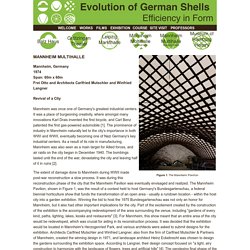
It was a place of burgeoning creativity, where amongst many innovations Karl Drais invented the first bicycle, and Carl Benz patented the first gas-powered automobile [1]. The extent of damage done to Mannheim during WWII made post-war reconstruction a slow process. The architects originally conceived of various designs for the pavilion before arriving at the final grid shell concept, the first of which was to create a roof over the exhibition space out of large umbrellas suspended on helium balloons, an idea which the planning authorities rejected [4]. Construction for the pavilion began in December 1973, and the lattice was gradually erected throughout April and June of the following year. Architecture in the Making - Home. ROK - Rippmann Oesterle Knauss GmbH. ROK - Rippmann Oesterle Knauss GmbH. Introspector.
03-OXMAN - material-based-design-computation.pdf. Bfm%3A978-1-4020-6695-5%2F1.pdf. RESEARCH PAVILION 2012 BY ICD/ITKE. In November 2012 the Institute for Computational Design (ICD) and the Institute of Building Structures and Structural Design (ITKE) at the University of Stuttgart have completed a research pavilion that is entirely robotically fabricated from carbon and glass fibre composites.
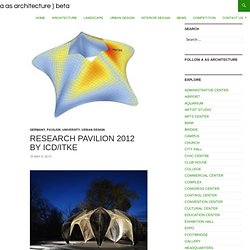
At the core of the project is the development of an innovative robotic fabrication process within the context of the building industry based on filament winding of carbon and glass fibres and the related computational design tools and simulation methods. ICD-ITKE Research Pavilion 2012. We checked out last years ICD-ITKE Research Pavilion in 2011 run by Pro.
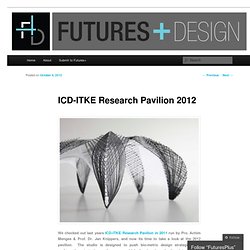
Achim Menges & Prof. Dr. Jan Knippers, and now its time to take a look at the 2012 pavilion. The studio is designed to push bio-metric design strategies and performative strategies, acting as a vehicle for “an investigation into integral structural, spatial and material systems.” The studio takes a the project from modelar studies to the full blown installation. Institute of Evolution and Ecology - Research. ICD/ITKE Research Pavilion 2013: Biologic Role Model: Beetle Elytra. 130129_designing_KREOD_web - 130129_designing_KREOD_web.pdf. The geometry experts. Structural Design Lab: Publications. Architecture and Design. P i n u p s p a c e. Architecture/code/art.
I haven’t yet decided how I want to manage the social-media-blogging component of my thesis process, which will begin in January when I return for my 10th and final semester.

In a way I am inclined to be somewhat schizophrenic about it, with different aspects appearing different places. If that’s the logic I follow, it will probably feature major milestones/completions here on this blog, images/fragments/visual ideas on Thetic, my tumblr, and in-depth theoretical discussions in a private circle on Google+ (if you are interested in contributing there, let me know and I’ll add you to the circle.) However, considering the end of my pre-thesis semester a “substantial completion” of some kind, I’ll post a bit here about the project I am proposing to pursue. My thesis is an attempt to tie together a number of threads with which I have been preoccupied over the last several years. Here’s the 2-minute pitch: Some of these results quite clearly resemble the original Eames House: 1. 2. Publications - Design Robotics Group. Andreani, S., and Bechthold, M.: “(Re)volving Brick: Geometry and Performance Innovation in Ceramic Building Systems Through Design Robotics.” in: Gramazio, K. et. al.
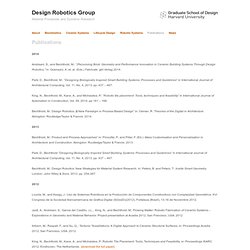
(Eds.) Fabricate. gbt Verlag 2014. Park, D., Bechthold, M.: “Designing Biologically Inspired Smart Building Systems: Processes and Guidelines” in International Journal of Architectural Computing, Vol. 11, No. 4, 2013, pp. 437 – 467. King, N., Bechthold, M., Kane, A., and Michalatos, P.: “Robotic tile placement: Tools, techniques and feasibility” in International Journal of Automation in Construction, Vol. 39, 2014, pp 161 – 166. Design Robotics Group - Material Processes and Systems Research. 2013 Conference. RESPONSIVE EXPANSION Sixto Cordero & Austin Smith Massachusetts Institute of Technology HYGROSKIN A climate-responsive prototype project based on the elastic and hygroscopic properties of wood David Correa University of Stuttgart, et al WORKING WITH MULTI-SCALE MATERIAL DISTRIBUTION Panagiotis Michalatos & Andrew O.
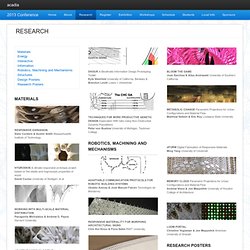
Payne Harvard University. Parametric Architecture. Posts Tagged ‘Parametric Architecture’ The installation synthesizes a spatial link of levels through both visual and physical connections.
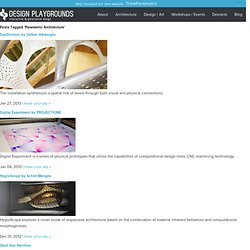
Digital Experiment is a series of physical prototypes that utilize the capabilities of computational design tools, CNC machining technology. HygroScope explores a novel mode of responsive architecture based on the combination of material inherent behaviour and computational morphogenesis. Shell Star, an installation for Detour: Design Renegade, an art and design festival in Hong Kong. LOTUS 7.0 is a living wall composed of smart foils that fold open in response to human behavior.
The MSc2 Studio – 1:1 prototypes (Spring 2012) conducted by Jelle Feringa at the Hyperbody research group invited Matthias Rippmann to teach about designing funicular shells Stone Spray is a revolutionary construction method which uses soil as the base material and a liquid binder to solidify the soil granules. BLOCK Research Group. This new technique demonstrate how the combination of compression-only shells with funicular tension rings leads to a great variety of efficient and expressive forms.

The research demonstrates how compression and tension forces can be explicitly controlled and manipulated locally in such structures, using a fully implemented, digital form-finding tool based on Thrust Network Analysis. Thanks to the flexible implementation, resulting shell designs range from simple symmetric shapes to complex, configurations with perforations in the shell and undulating ridge edges. Independent of their complexity, all resulting shells are subject to the clear and comprehensible structural system.
BLOCK Research Group. BibTeX: @inproceedings{Rippmann2013c, author = "Rippmann, M. and Block, P.
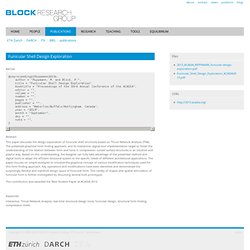
", title = "Funicular Shell Design Exploration", booktitle = "Proceedings of the 33rd Annual Conference of the ACADIA", editor = "", volume = "", number = "", pages = "", publisher = "", address = "Waterloo/Buffalo/Nottingham, Canada", year = "2013", month = "September", doi = "", note = "", } Abstract: This paper discusses the design exploration of funicular shell structures based on Thrust Network Analysis (TNA). This contribution was awarded the 'Best Student Paper' at ACADIA 2013. BLOCK Research Group. Free-form Catalan Thin-tile vault This research project presents advances in timbrel vaulting, made possible through innovation in form finding, guidework systems and construction methods.
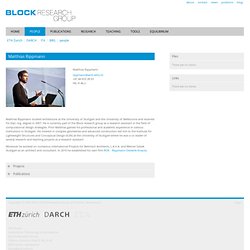
MLK Jr. ACADIA. Oliver David Krieg. Today I want to show you four videos of the ICD / ITKE Research Pavillon 2011 development and production process. The last two videos have been shown on the ICD’s facebook page a few weeks ago while the first two are new and reveal a bit of the design process that took place before the production began. Video 1: Design Tool Form-finding through the integration of biomimetic principles, manufacturing constraints and physical simulation The main design tool we used for the final form-finding process is able to implement not only the principles and constraints we developed in the fields of biomimetics, fabrication and material behavior in the weeks before, but also architectural intentions and spatial qualities.
As you can see in the first seconds of the video a cellular, circular mesh is being laid out on a flat plane. Each cell in this mesh represents one wooden cell of the pavilion as it can be seen later in the video. Then, the cells’ morphology changes to their final polygonal shape. Nested Catenaries. Nested Catenaries - 2010 - ongoing Nested Catenaries is an ongoing research project in the performance-oriented design research area that investigates the structural and multi-functional capacity of masonry catenary arches and vaults. Research Team Phase 01 Defne Sunguroğlu Hensel, Doctoral Research Fellow, AHO, Oslo Øyvind Buset, Master Mason, Oslo Phase 02. Cellular. Posts Tagged ‘Cellular’ SCIN Cube Location: London Design Festival, SCIN GalleryDate: 2012Materials: 3D Printed ConcreteTools: Rhino, Grasshopper, WeaverbirdDimensions: 20cm x 20cm x 20cm Project DescriptionSCIN, a material resource center for designers and architects in London, asked a small group of emerging designers to produce a small cube that represents their approach to design, materiality, and technology for an exhibition that coincides with the London Design Festival.
Our submission reflects the reoccurring presence in our work of cellular solids, a transmaterial grouping characterized by high strength to weight ratios. ArboSkin Bioplastic Façade Research (ITKE) ArboSkin is a Bioplastic Façade Research Project developed at ITKE (Institute of Building Structures and Structural Design) ,Institution that has many years of experience in teaching and research in the fields of computer based design, simulation, and production of cladding for buildings with complex geometries. Currently, materials made from oil-based plastics, glass, or metal are mainly used to encase these structures.
Thermoformable sheets of bioplastics will represent a resource-efficient alternative in the future, as they combine the high malleability and recyclability of plastics with the environmental benefits of materials consisting primarily of renewable resources. ArboSkin Video Clip: Short clip about the EFRE funded bioplastic facade from itke on Vimeo. Cocoon EVO pavilion. RADIOLARIA. RADIOLARIA. Radiolaria Project.